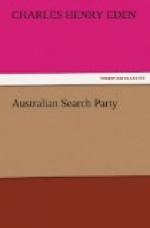The uses to which the settler puts this animal are many. He has to take the place of the stag when any hunting is going on (as the dingo has to act for the fox); and most remarkably good sport an “old man” or “boomer” — as the full-grown males are called — will afford; and most kangaroo dogs bear witness, by cruel scars, how keen a gash he can inflict with his sharp hind claw when brought to bay. From ten to twelve miles is by no means an unusual run, and when thoroughly exhausted he makes a stand, either with his back against a tree, or in the water. In both of these positions he is no despicable adversary, and will do much damage to a pack of hounds, by grasping them in his short fore arms and ripping them open, if on land; or by seizing and holding them under, if in the water. Instances are on record of a despairing kangaroo dashing through the dogs on the approach of a dismounted hunter, and severely wounding him. The common practice when the animal is brought to bay is to ride up and pistol him. But, however he may be killed, his useful qualities have by no means departed with his breath. His skin, properly cured, will make good door-mats, boots, saddle-cloths, stock-whips, gaiters, and numberless other useful articles. His long and heavy tail is much valued for the soup it yields; and the hams can be cured, and, thus preserved, find many admirers. The hind-quarters of a large “boomer” will run little short of seventy pounds; and, with the tail, form the only parts commonly eaten by Europeans.
The birds that we encountered were of every form and size; pigeons, some coloured like parrots, others diminutive as sparrows, and of the same sombre hue: pheasants, quail, every kind of feathered fowl that could gladden the heart of the sportsman, were found in abundance, and amongst these the scrub turkey and its nest. This latter bird is so little known, that I am tempted to give a short account of it.
The Australian scrub turkey (’Tallegalla Lathami’) is common in all the thick jungles in the north of Queensland, and, though smaller than the domestic bird, is sufficiently like it to be easily recognised, having the same wattle, and neck denuded of feathers. The most remarkable feature about this turkey is its nest, which is composed of sand, leaves, and sticks, piled up into a great mound three feet or so in height, and ten or more in diameter. This enormous mass is not the unaided work of one pair, but of a whole colony, and the material is got together by the bird grasping a quantity in its foot, and throwing it behind him; the ground in the immediate vicinity of the mound is thus entirely stripped of every blade of grass,or fallen leaf. In process of time, the heap partially decomposes, and when the female judges that enough heat has been engendered to serve her purpose, she proceeds to lay her eggs. These are enormous when compared with the size of the bird, and are not simply deposited and covered over, but buried at a




